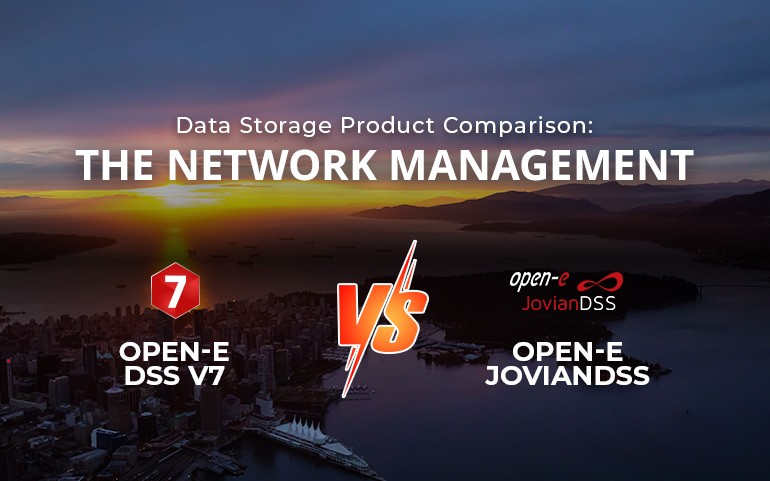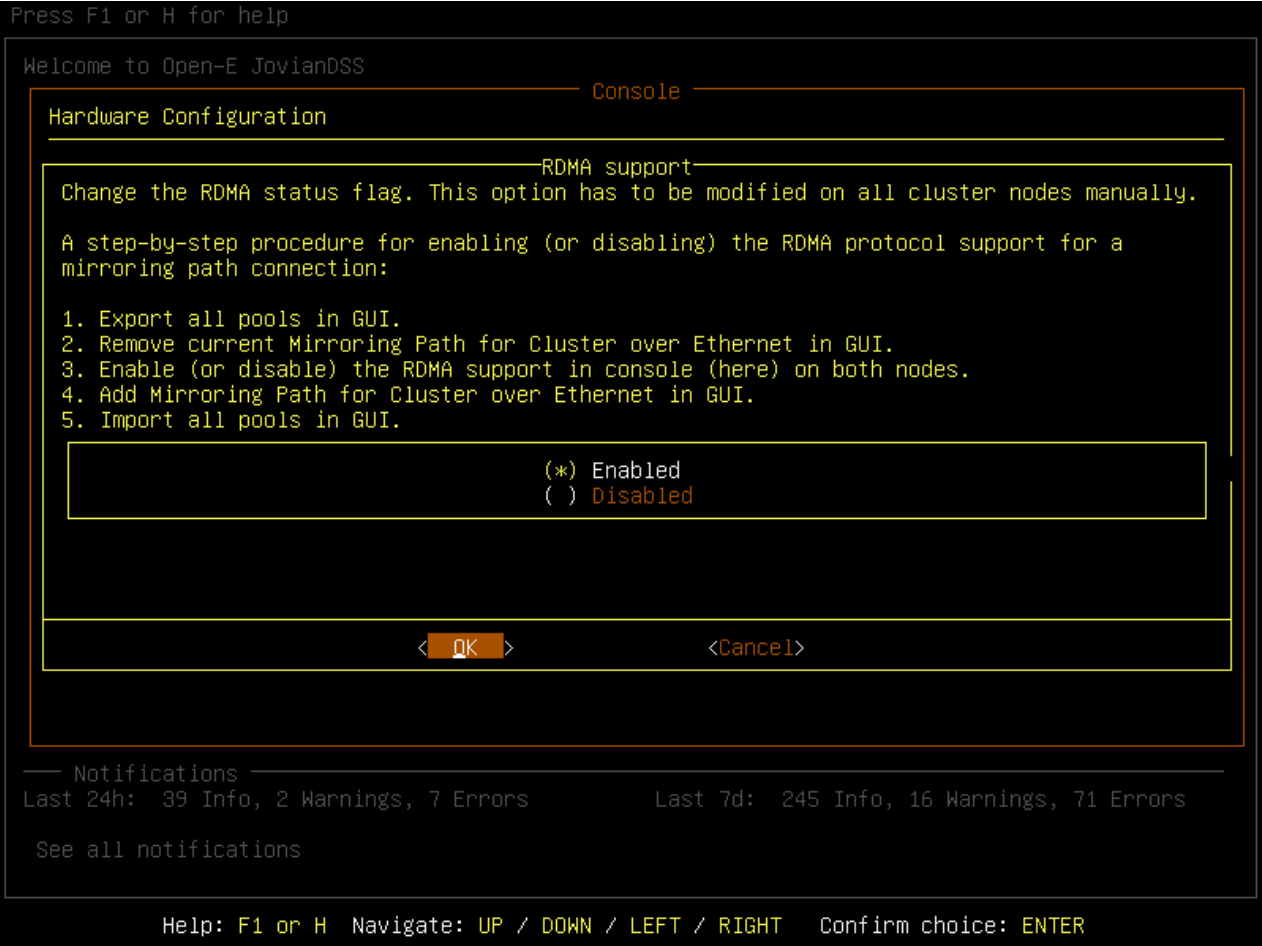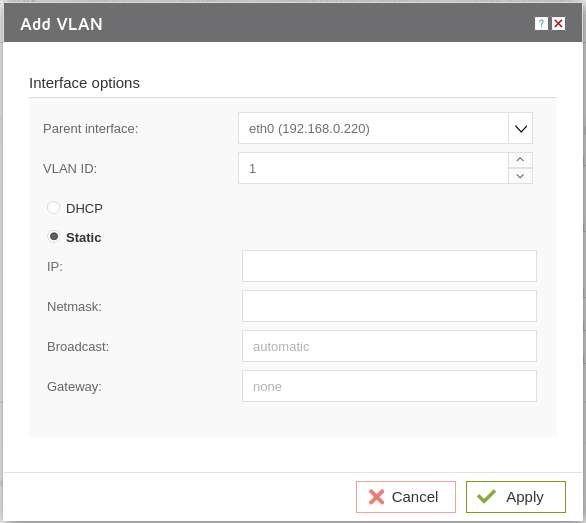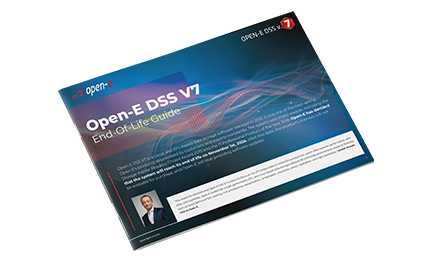Open-E DSS V7 vs Open-E JovianDSS - The Administration
A while ago, we presented you with a short Features Comparison Between Open-E JovianDSS and…
Read More
As Open-E DSS V7 ends its life this year in October, we have already published an article showing the differences between Open-E JovianDSS and Open-E DSS V7. Users who still use Open-E DSS V7 can be more aware of how they can enhance their data storage infrastructure by transitioning to Open-E JovianDSS. The article also allows users to compare the two products easily, highlighting how the advanced features in Open-E JovianDSS improve the management of the data storage infrastructure.
In our first detailed article, we explored the Administration module. We are excited to present a new one describing Network Management.
The Network Management module in Open-E JovianDSS offers two main features related to network management that suppress its predecessor. They are:
| Feature | Open-E JovianDSS | Open-E DSS V7 |
|---|---|---|
| RDMA support on Mirror Path | yes | no |
| VLAN | yes | no |
Remote Direct Memory Access (RDMA) allows direct access from one computer’s memory into another without involving either operating system. This provides high-throughput, low-latency networking, particularly advantageous in data-intensive applications such as storage systems. In the context of Open-E JovianDSS, RDMA support on the mirror path offers several significant benefits.

Low Latency: RDMA drastically reduces the latency of data transfers between nodes in a mirrored storage setup. This is crucial for maintaining high performance in synchronous replication scenarios where data consistency across multiple locations is essential.
High Throughput: RDMA enables high-speed data transfers, making it suitable for environments that require rapid data access and processing, such as high-performance computing and large-scale enterprise applications.
Reduced CPU Load: By bypassing the CPU for data transfer tasks, RDMA frees up CPU resources for other critical operations. This offloading helps improve overall system performance and efficiency.
Network Efficiency: RDMA uses zero-copy networking, meaning data is transferred directly from the source to the destination without intermediate buffering. This minimizes the number of data copies and reduces memory bandwidth consumption.
Reduced Latency Jitter: Consistent low-latency communication provided by RDMA helps achieve predictable performance, which is essential for applications requiring real-time data processing.
Seamless Scaling: RDMA’s ability to maintain high performance as the system scales makes it ideal for growing data storage infrastructures. It supports large-scale deployments without significant performance degradation.
High Availability: RDMA’s efficiency in handling large volumes of data transfers contributes to building highly available and resilient data storage systems, ensuring quick data replication and recovery.
Unlike Open-E DSS V7, Open-E JovianDSS offers Virtual Local Area Networks support. It allows tagging multiple VLANs and connecting them to a single network interface. This feature enables efficient network segmentation and management, facilitates diverse network traffic isolation, and better utilizes network resources.

Isolation of Traffic: VLANs allow you to segment network traffic logically, which helps isolate different types of traffic. For example, you can separate management traffic from data storage traffic, enhancing security and reducing congestion.
Improved Security: By isolating different types of network traffic, VLANs help prevent unauthorized access to sensitive data and reduce the risk of security breaches.
Simplified Administration: VLANs simplify network administration by allowing network managers to create and manage virtual networks through software configurations rather than physical changes to the network setup.
Scalability: VLANs make it easier to scale the network by adding new virtual networks without needing additional physical infrastructure.
Dynamic Network Configuration: VLANs allow the network to be reconfigured dynamically, adapting to changing requirements without significant downtime or hardware changes.
Support for Multi-Tenant Environments: VLANs are particularly useful in multi-tenant environments, such as data centers and cloud services, where different tenants’ traffic needs to be securely isolated.
In modern data center and cloud environments, VLANs play a serious role in enhancing security, optimizing resources, and ensuring efficient network management. Below are the key use cases highlighting the benefits of VLANs in data storage and cloud infrastructure.
Multi-Tenant Isolation: VLANs provide secure isolation for different tenants, ensuring that each tenant’s data remains private and segregated.
Resource Optimization: Efficiently manage and allocate network resources to various applications and services hosted within the data center.
Departmental Segmentation: Separate network traffic for different departments (e.g., finance, HR, IT) to enhance security and manageability.
Guest Networks: Create isolated guest networks that provide Internet access without exposing internal resources.
Dedicated Storage Traffic: VLANs can be used to dedicate specific network segments to data storage traffic, isolating it from other types of traffic and improving performance and reliability.
Storage Area Networks (SANs): Implementing VLANs to segregate SAN traffic from regular network traffic, ensuring optimal performance and reducing the risk of congestion.
Data Backup and Replication: Using VLANs to create dedicated pathways for backup and replication traffic, ensuring that other network activities do not disrupt these critical operations.
Disaster Recovery: Isolating disaster recovery sites on separate VLANs to ensure secure and efficient data transfer during recovery operations.
Access Control: Creating VLANs to restrict access to sensitive storage resources, ensuring that only authorized users and devices can access specific data stores.
As you can see, these two new Open-E JovianDSS functionalities, not present on Open-E DSS V7, allow you to enhance and make it much easier to manage the network part of your data storage infrastructure.

If you wish to know more about the Open-E JovianDSS features we have prepared a compact brochure covering all the essential information about the upcoming End-of-Life for Open-E DSS V7.
Download it now to explore potential scenarios for current Open-E DSS V7 users and discover the opportunities to upgrade your data storage system to Open-E JovianDSS. Click on the banner below to access the document.
Leave a Reply